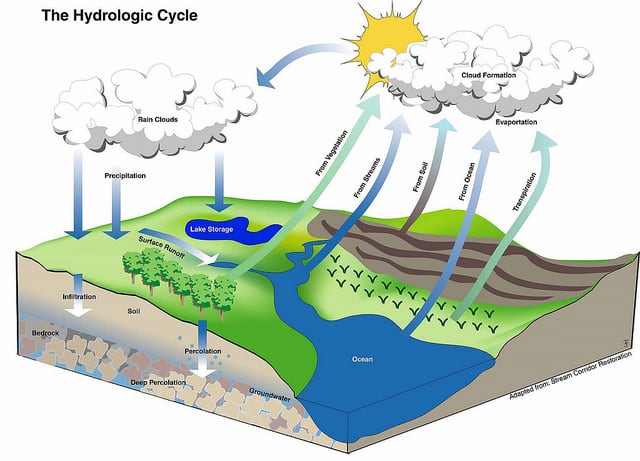The water cycle also known as the hydrologic cycle or the hydrological cycle describes the continuous movement of water on above and below the surface of the Earth. Consequently the water cycle is also called the hydrologic cycle in many scientific textbooks and educational materials.

What Is The Hydrologic Cycle And Steps Of The Hydrologic Cycle Conserve Energy Future
They transmit huge quantities of water into the atmosphere via the transpiration of plants in which plants release water from their leaves during photosynthesis and from evaporation from their leaves.

Describe the hydrologic cycle. It is a cycle that replenishes ground water supplies. Evaporation Condensation Surface runoff. After reading this article you will learn about the hydrologic cycle and its components.
Lake effect snowfallis good example of the hydrologic cycle at work. Of the many processes involved in the water cycle the most important are evaporation transpiration condensation precipitation and runoff. Hydrological cycle within a drainage basin The hydrological cycle within a drainage basin is different to a global hydrological system in that it is an open system and input water transfer and.
Condensation is caused when the air cools water vapor until it reaches its saturation point. Once water reaches this point and turns into a liquid it releases all of the energy it used to get to a gaseous state. Water cycle also called hydrologic cycle cycle that involves the continuous circulation of water in the Earth-atmosphere system.
An illustrated explanation of the hydrological cycle introducing key terms. HYDROLOGIC CYCLE The hydrologic cycle is a constant movement of water above on and below the earths surface. Hydrological Cycle and Water Budgets.
Although the total amount of water within the cycle remains essentially constant its distribution among the various processes is continually changing. Water in the atmosphere in the ocean on land and underground is linked and changing one modifies the others. The water cycle also known as the hydrologic cycle defines the movement and storage of water through Earth.
Runoff a potential carrier of nutrients and sediment to streams and lakes is best described in the science of hydrology. The water cycle may also be referred to as the hydrologic cycle. It is concerned with the origin distribution and properties of water on the globe.
The hydrologic cycle also known as global water cycle or the H2O cycle describes the storage and movement of water between the biosphere atmosphere lithosphere and the hydrosphere. During this process water changes its state from one phase to another but the total number of water particles remains the same. The water cycle is the continuous process of how that water moves across the Earth and through the atmosphere connecting it all together.
The hydrologic cycle is an interactive system. Its simply transformed transported and recycled. The concept of hydrological cycle is elegantly simple.
The water cycle also known as the hydrologic cycle or the hydrological cycle describes the continuous movement of water on above and below the surface of the Earth. According to Wikipedia The water cycle also known as the hydrological cycle or the H2O cycle describes the continuous movement of water on above and below the surface of the Earth. Condensation is the process where the water vapor turns into a liquid and forms clouds.
The water or hydrologic cycle describes the pilgrimage of water as water molecules make their way from the Earths surface to the atmosphere and back again in some cases to below the surface. The hydrologic cycle has three main stages. Since water plays a major role in weather and climate it is important to understand the hydrologic cycle.
This gigantic system powered by energy from the Sun is a continuous exchange of moisture between the oceans the atmosphere and the land. The cycle begins as cold winds horizontal blue arrows blow across a large lake. Hydrologic cycle that contribute to the production of lake effect snow.
Environmental scientists know that the hydrologic cycle includes various processes that change water from solid to liquid to gas form and transport it to every corner of earths surface and below. The scientific discipline in the field of physical geography that deals with the water cycle is called hydrology. But its importance in the.
It begins as water vaporizes into the atmosphere from vegetation soil lakes rivers snowfields and oceans-a process called evapotranspiration. Hydrological Cycle Aquatic Environment. Menegaki in Environment and Development 2016 Hydrological cycle is also.
Role of forests in the hydrological cycle Forests play a very important role within the global and local hydrological cycles. Water can be found all around. The process is made up of six major steps and while it may change slightly from time to time it never ends or begins.
Water on Earth is constantly moving and changing states. A change in one component of the hydrologic cycle can affect weather. In terms of water the earth is a closed system so water isnt added or removed from earth.